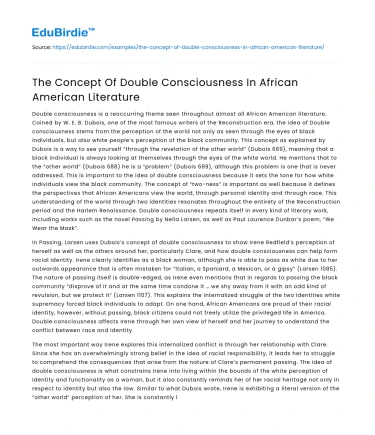Double consciousness is a reoccurring theme seen throughout almost all African American literature. Coined by W. E. B. Dubois, one of the most famous writers of the Reconstruction era, the idea of Double consciousness stems from the perception of the world not only as seen through the eyes of black individuals, but also white people’s perception of the black community. This concept as explained by Dubois is a way to see yourself “through the revelation of the other world” (Dubois 689), meaning that a black individual is always looking at themselves through the eyes of the white world. He mentions that to the “other world” (Dubois 688) he is a “problem” (Dubois 689), although this problem is one that is never addressed. This is important to the idea of double consciousness because it sets the tone for how white individuals view the black community. The concept of “two-ness” is important as well because it defines the perspectives that African Americans view the world, through personal identity and through race. This understanding of the world through two identities resonates throughout the entirety of the Reconstruction period and the Harlem Renaissance. Double consciousness repeats itself in every kind of literary work, including works such as the novel Passing by Nella Larsen, as well as Paul Laurence Dunbar’s poem, “We Wear the Mask”.
In Passing, Larsen uses Dubois’s concept of double consciousness to show Irene Redfield’s perception of herself as well as the others around her, particularly Clare, and how double consciousness can help form racial identity. Irene clearly identifies as a black woman, although she is able to pass as white due to her outwards appearance that is often mistaken for “Italian, a Spaniard, a Mexican, or a gipsy” (Larsen 1085). The nature of passing itself is double-edged, as Irene even mentions that in regards to passing the black community “disprove of it and at the same time condone it … we shy away from it with an odd kind of revulsion, but we protect it” (Larsen 1107). This explains the internalized struggle of the two identities white supremacy forced black individuals to adapt. On one hand, African Americans are proud of their racial identity, however, without passing, black citizens could not freely utilize the privileged life in America. Double consciousness affects Irene through her own view of herself and her journey to understand the conflict between race and identity.
Save your time!
We can take care of your essay
- Proper editing and formatting
- Free revision, title page, and bibliography
- Flexible prices and money-back guarantee
The most important way Irene explores this internalized conflict is through her relationship with Clare. Since she has an overwhelmingly strong belief in the idea of racial responsibility, it leads her to struggle to comprehend the consequences that arise from the nature of Clare’s permanent passing. The idea of double consciousness is what constrains Irene into living within the bounds of the white perception of identity and functionality as a woman, but it also constantly reminds her of her racial heritage not only in respect to identity but also the law. Similar to what Dubois wrote, Irene is exhibiting a literal version of the “other world” perception of her. She is constantly looking at herself “through the eyes of others” (Dubois 689) and experiencing the concept of “two-ness”.
In Paul Dunbar’s poem “We Wear the Mask” the notion of double consciousness is presented by expressing the idea of the Veil, or “the mask”, which is the effect that double consciousness has on black identity. Dunbar refers to this concept as “the mask” and uses it to show how black citizens took advantage of the white population’s perception of blackness. In the second stanza, Dunbar mentions that the world should not be able to constantly scrutinize the black community by focusing on the misfortunes perpetuated by white supremacy and racial prejudice. He concludes the stanza by exclaiming “Nay, let them only see us while/ We wear the mask!” (Dunbar 906) which effectively tells the audience that black individuals have the power to utilize the veil formed by double consciousness to their advantage. By being able to shift and switch their perception of the world around them to fit into what white America expects, black citizens are able to shield one side of their “two-ness”. Dunbar is expressing that by shifting their consciousness, black people are able to remain safe because their true identity remains unseen by white oppressors.
While the idea of double consciousness is not expressed exactly the same way across the board, it is evident that many black writers and artists used this concept in order to display what a two-sided or doubled identity meant to them. In Larsen’s Passing, double consciousness allowed for the exploration of racial identity through the internalized confusion involving race and identity. In Dunbar’s “We Wear the Mask”, double consciousness is what allows black citizens to shield and spare themselves from direct ridicule and mistreatment. While all of these use double consciousness in different ways, these texts express the root of Dubois’s concept of double consciousness, identifying oneself through both your own idea of the self as well as the perception of others.






 Stuck on your essay?
Stuck on your essay?

